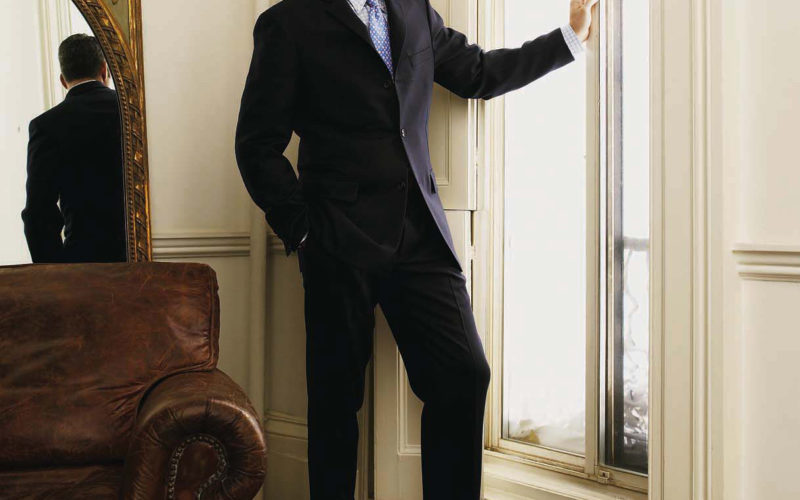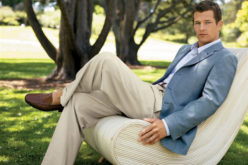Q. I have a business trip to Italy coming up (during which time I will also be meeting friends of my wife’s family). She insists that I need to dress more formally than I do for my office here. Is that really the case or is that just the impression we have of Europeans from magazines and movies? I don’t want to carefully pack suits and blazers and never use them.
A. Europeans look and feel better in clothes that are not ordinary or run of the mill. Formality is not the issue with European dressers. They respect subtlety, value quality, and strive for an air of unique, good looks in their clothes. They would never overdress or wear anything that is flashy or unkempt. Their interest is in a quietly smart look that says “elegant” and “timeless.”
If you are doing business overseas, it is important to remember that no one is more attuned to dress than a European businessman, especially one from Italy. (He may not own as many clothes as an American, but each outfit he wears looks terrific and fits perfectly.) Never wear brightly-colored trousers – the kind that make their way to weekend cocktail parties in Connecticut – and do not wear trousers that are too long or too short.
All your outfits should be about as sophisticated as you can make them. You might include such elegant sportswear as a silk and linen sports jacket in a softer and less-constructed look than a blazer – perhaps worn with a handsome small-plaid shirt and fine wool trousers. Or wear a solid-color shirt under a patterned cashmere sweater and no jacket. Both of these looks work with, or without, a tie. Lately, American boating-type shoes are popular in Europe with casual clothes.
An indisputably classic combination, guaranteed to be accepted, is a navy blazer, powder blue point-collar broadcloth shirt, navy-and-white striped repp tie, and perfectly-tailored gray (or tan) fine wool gabardine trousers. Wear these with polished medium-weight shoes in black or cognac. If you should be invited to a friend’s home for dinner (Europeans are uncommonly gracious to visiting business associates and entertain quite grandly), the same type of outfit is perfect, especially if the shirt has French cuffs.
Some years ago I was in Treviso, a small city north of Venice, on a business trip with my husband. We were taken on a plant visit and out to lunch by the head of the company.
Apparently we impressed Giorgio, our host, because we were then invited to his home for the following evening’s dinner. He assured us that it would be quite “simple.” I assured my husband, however, that nothing about the dinner would be simple, How did I know? he asked. I said, “Anyone who shows up in a sporty little Fiat, as Giorgio did, dressed in such a studiedly casual way with smart leather driving gloves and fine shoes to show us around a stone quarry, would not do anything in a simple way. Least of all would he give a ‘simple’ dinner party.”
I also believed I had detected a style peculiar to the region. The style was that of wearing French cuffs open; that is to say, unfastened, without cuff links. My husband, a pretty sharp dresser himself, said that perhaps Giorgio had just forgotten to put them on. I said “That man? He would never forget anything in an outfit. No, I’m sure it’s the style.”
The next evening we arrived at a jewel of an Italian villa. It was decorated entirely with matching velvet furniture. Our host’s wife had been a model in Milan; she swept into the room in that distinctive way of walking that models have, looking gorgeous.
Giorgio and two other male guests all wore French-cuffed shirts, devoid of cuff links. My guess was right.
Later I learned the reason for their “lapse.” Italian men in that upper social stratum all dressed so absolutely perfectly that, in order not to appear as dandies who were overly involved with how they looked, they purposely created a mistake in their appearance. In the same way, weavers of the world’s finest Oriental silk rugs purposely cast a mistake into the design. Nothing should be too perfect.
This sort of studied nonchalance has a name, “sprezzatura.” The Italian word first appeared in 1528 in Baldassare Castiglione’s “The Book of the Courtier,” where it was defined by the author as “a certain nonchalance, so as to conceal all art and make whatever one does or says appear to be without effort and almost without any thought about it.” When the word entered the English language, the Oxford English Dictionary defined it as “studied carelessness.”
I hope you enjoy your trip. My advice: be sure to go into one of the small men’s shops and treat yourself to something that you will wear and enjoy for years.
Please send your men’s dress and grooming questions and comments to MALE CALL: Lois.Fenton@prodigy.net









